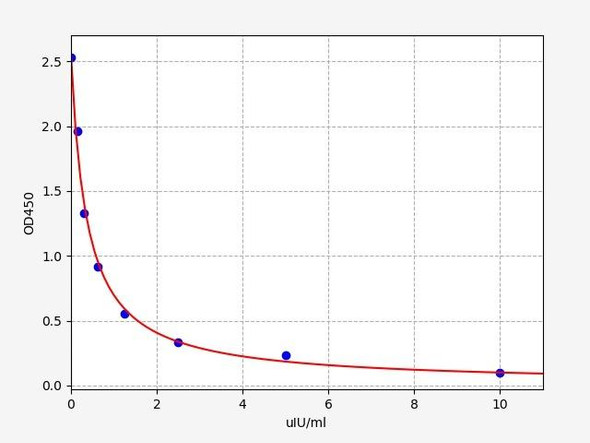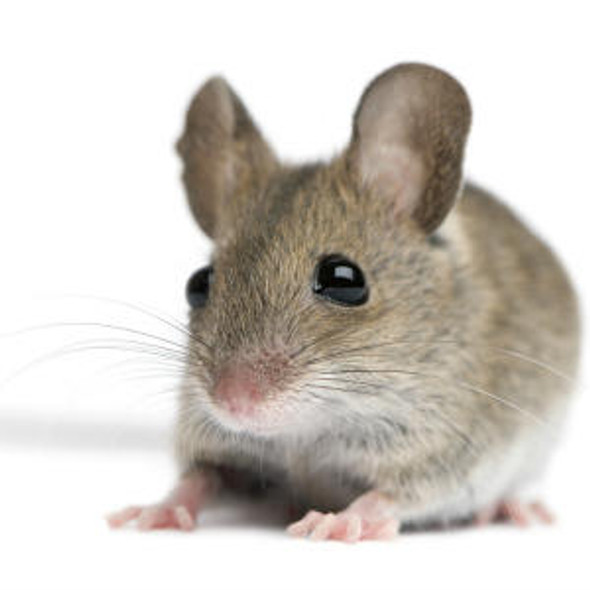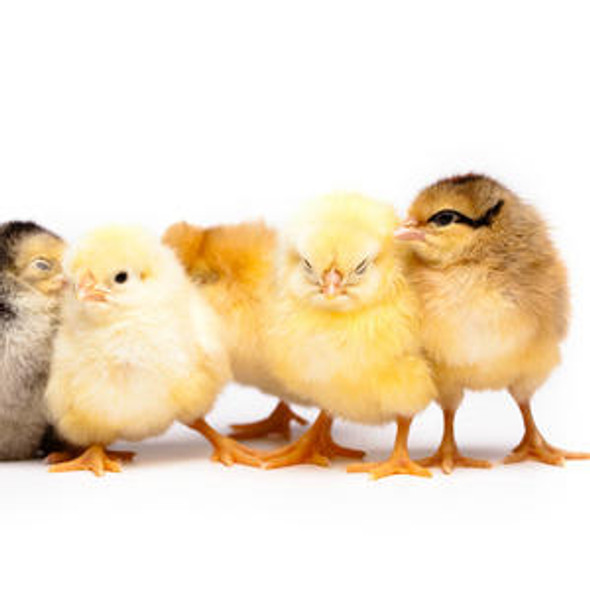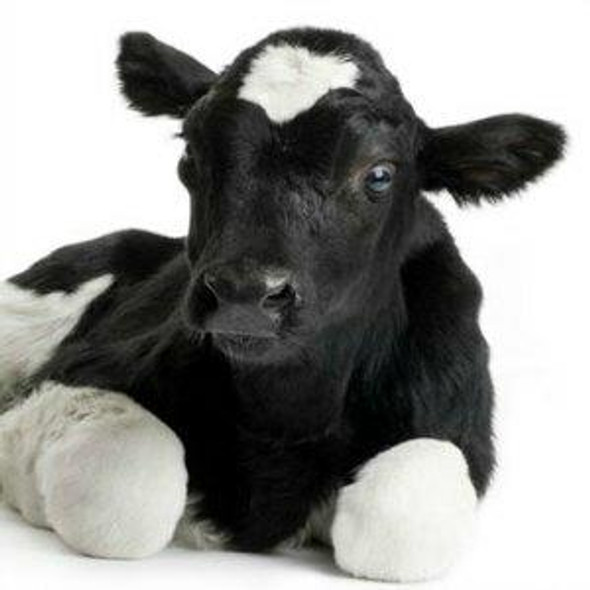Rat Thyrotropin subunit beta / TSHB ELISA Kit
- SKU:
- RTFI00056
- Product Type:
- ELISA Kit
- Size:
- 96 Assays
- Uniprot:
- P04652
- Sensitivity:
- 0.094uIU/ml
- Range:
- 0.156-10uIU/ml
- ELISA Type:
- Competitive
- Synonyms:
- Tshb, Thyrotropin subunit beta, Thyrotropin beta, thyroid stimulating hormone, beta, thyroid-stimulating hormone subunit beta, thyrotropin beta chain, thyrotropin beta subunit, TSH-B, TSH-BETA
- Reactivity:
- Rat
Description
Rat Thyrotropin subunit beta/TSHB ELISA Kit
The Rat Thyrotropin Subunit Beta (TSHB) ELISA Kit is specifically designed for the accurate and sensitive detection of TSHB levels in rat serum, plasma, and cell culture supernatants. This kit boasts high sensitivity and specificity, ensuring reliable and reproducible results for a variety of research applications.TSHB is a key hormone involved in the regulation of thyroid function, playing a central role in the maintenance of metabolism, growth, and development.
Dysregulation of TSHB levels can lead to thyroid disorders such as hypothyroidism and hyperthyroidism, making it a critical biomarker for studying these conditions and exploring potential therapeutic interventions.With its advanced technology and superior performance, the Rat TSHB ELISA Kit from Assay Genie is an invaluable tool for researchers looking to investigate the role of TSHB in thyroid function and related disorders.
| Product Name: | Rat Tshb (Thyrotropin subunit beta) ELISA Kit |
| Product Code: | RTFI00056 |
| Size: | 96 Assays |
| Target: | Rat Tshb |
| Alias: | Tshb, Thyrotropin subunit beta, Thyrotropin beta, thyroid stimulating hormone, beta, thyroid-stimulating hormone subunit beta, thyrotropin beta chain, thyrotropin beta subunit, TSH-B, TSH-BETA |
| Reactivity: | Rat |
| Detection Method: | Competitive ELISA, Coated with Antibody |
| Sensitivity: | 0.094uIU/ml |
| Range: | 0.156-10uIU/ml |
| Storage: | 4°C for 6 months |
| Note: | For Research Use Only |
| Recovery: | Matrices listed below were spiked with certain level of Rat Tshb and the recovery rates were calculated by comparing the measured value to the expected amount of Rat Tshb in samples. | ||||||||||||||||
| |||||||||||||||||
| Linearity: | The linearity of the kit was assayed by testing samples spiked with appropriate concentration of Rat Tshb and their serial dilutions. The results were demonstrated by the percentage of calculated concentration to the expected. | ||||||||||||||||
| |||||||||||||||||
| Intra-Assay: | CV <8% | ||||||||||||||||
| Inter-Assay: | CV <10% |
| Uniprot: | P04652 |
| UniProt Protein Function: | TSHB: Indispensable for the control of thyroid structure and metabolism. Belongs to the glycoprotein hormones subunit beta family. |
| UniProt Protein Details: | Protein type:Secreted, signal peptide; Secreted Chromosomal Location of Human Ortholog: 1p13 Cellular Component: extracellular region Molecular Function:hormone activity Biological Process: G-protein coupled receptor protein signaling pathway; anatomical structure morphogenesis; cellular protein metabolic process; cell-cell signaling; response to estrogen stimulus; peptide hormone processing; response to calcium ion; response to vitamin A Disease: Hypothyroidism, Congenital, Nongoitrous, 4 |
| NCBI Summary: | The four human glycoprotein hormones chorionic gonadotropin (CG), luteinizing hormone (LH), follicle stimulating hormone (FSH), and thyroid stimulating hormone (TSH) are dimers consisting of alpha and beta subunits that are associated noncovalently. The alpha subunits of these hormones are identical, however, their beta chains are unique and confer biological specificity. Thyroid stimulating hormone functions in the control of thyroid structure and metabolism. The protein encoded by this gene is the beta subunit of thyroid stimulating hormone. Mutations in this gene are associated with congenital central and secondary hypothyroidism and Hashimoto's thyroiditis. Alternative splicing of this gene results in multiple transcript variants. [provided by RefSeq, May 2013] |
| UniProt Code: | P04652 |
| NCBI GenInfo Identifier: | 115430099 |
| NCBI Gene ID: | 7252 |
| NCBI Accession: | NP_000540.2 |
| UniProt Secondary Accession: | P04652,P12656, P04652, |
| UniProt Related Accession: | P01222 |
| Molecular Weight: | 10,624 Da |
| NCBI Full Name: | thyrotropin subunit beta isoform 1 |
| NCBI Synonym Full Names: | thyroid stimulating hormone, beta |
| NCBI Official Symbol: | TSHB |
| NCBI Official Synonym Symbols: | TSH-B; TSH-BETA |
| NCBI Protein Information: | thyrotropin subunit beta; thyrotropin beta chain |
| UniProt Protein Name: | Thyrotropin subunit beta |
| UniProt Synonym Protein Names: | Thyroid-stimulating hormone subunit beta; TSH-B; TSH-beta; Thyrotropin beta chain; INN: Thyrotropin alfa |
| Protein Family: | Thyrotropin |
| UniProt Gene Name: | TSHB |
| UniProt Entry Name: | TSHB_HUMAN |
| Step | Procedure |
| 1. | Set standard, test sample and control (zero) wells on the pre-coated plate respectively, and then, record their positions. It is recommended to measure each standard and sample in duplicate. Wash plate 2 times before adding standard, sample and control (zero) wells! |
| 2. | Add Sample and Biotin-detection antibody: Add 50µL of Standard, Blank or Sample per well. The blank well is added with Sample Dilution Buffer. Immediately add 50 µL of biotin-labelled antibody working solution to each well. Cover with the plate sealer provided. Gently tap the plate to ensure thorough mixing. Incubate for 45 minutes at 37°C. (Solutions are added to the bottom of micro-ELISA plate well, avoid touching plate walls and foaming). |
| 3. | Wash: Aspirate each well and wash, repeating the process three times. Wash by filling each well with Wash Buffer (approximately 350µL) using a squirt bottle, multi-channel pipette, manifold dispenser or automated washer. Complete removal of liquid at each step is essential to good performance. After the last wash, remove any remaining Wash Buffer by aspirating or decanting. Invert the plate and pat it against thick clean absorbent paper. |
| 4. | HRP-Streptavidin Conjugate(SABC): Add 100µL of SABC working solution to each well. Cover with a new Plate sealer. Incubate for 30 minutes at 37°C. |
| 5. | Wash: Repeat the aspiration/wash process for five times. |
| 6. | TMB Substrate: Add 90µL of TMB Substrate to each well. Cover with a new plate sealer. Incubate for about 10-20 minutes at 37°C. Protect from light. The reaction time can be shortened or extended according to the actual color change, but not more than 30 minutes. When apparent gradient appeared in standard wells, you can terminate the reaction. |
| 7. | Stop: Add 50µL of Stop Solution to each well. Color turn to yellow immediately. The adding order of stop solution should be as the same as the substrate solution. |
| 8. | OD Measurement: Determine the optical density (OD Value) of each well at once, using a microplate reader set to 450 nm. You should open the microplate reader ahead, preheat the instrument, and set the testing parameters. |
When carrying out an ELISA assay it is important to prepare your samples in order to achieve the best possible results. Below we have a list of procedures for the preparation of samples for different sample types.
| Sample Type | Protocol |
| Serum: | If using serum separator tubes, allow samples to clot for 30 minutes at room temperature. Centrifuge for 10 minutes at 1,000x g. Collect the serum fraction and assay promptly or aliquot and store the samples at -80°C. Avoid multiple freeze-thaw cycles. If serum separator tubes are not being used, allow samples to clotovernight at 2-8°C. Centrifuge for 10 minutes at 1,000x g. Removeserum and assay promptly or aliquot and store the samples at-80°C. Avoid multiple freeze-thaw cycles. |
| Plasma: | Collect plasma using EDTA or heparin as an anti-coagulant. Centrifuge samples at 4°C for 15 mins at 1000 - g within 30 mins of collection. Collect the plasma fraction and assay promptly or aliquot and store the samples at -80°C. Avoid multiple freeze-thaw cycles.Note: Over haemolysed samples are not suitable for use with this kit. |
| Urine & Cerebrospinal Fluid: | Collect the urine (mid-stream) in a sterile container, centrifuge for 20 mins at 2000-3000 rpm. Remove supernatant and assay immediately. If any precipitation is detected, repeat the centrifugation step. A similar protocol can be used for cerebrospinal fluid. |
| Cell Culture Supernatant: | Collect the cell culture media by pipette, followed by centrifugation at 4°C for 20 mins at 1500 rpm. Collect the clear supernatant and assay immediately. |
| Cell Lysates: | Solubilize cells in lysis buffer and allow to sit on ice for 30 minutes. Centrifuge tubes at 14,000 x g for 5 minutes to remove insoluble material. Aliquot the supernatant into a new tube and discard the remaining whole cell extract. Quantify total protein concentration using a total protein assay. Assay immediately or aliquot and store at ≤ -20°C. |
| Tissue Homogenates: | The preparation of tissue homogenates will vary depending upon tissue type. Rinse tissue with 1X PBS to remove excess blood & homogenizein 20ml of 1X PBS (including protease inhibitors) and store overnight at ≤ -20°C. Two freeze-thaw cycles are required to break the cell membranes. To further disrupt the cell membranes you can sonicate the samples. Centrifuge homogenates for 5 mins at 5000xg. Remove the supernatant and assay immediately or aliquot and store at -20°C or-80°C. |
| Tissue Lysates: | Rinse tissue with PBS, cut into 1-2 mm pieces, and homogenize with a tissue homogenizer in PBS. Add an equal volume of RIPA buffer containing protease inhibitors and lyse tissues at room temperature for 30 minutes with gentle agitation. Centrifuge to remove debris. Quantify total protein concentration using a total protein assay. Assay immediately or aliquot and store at ≤ -20 °C. |
| Breast Milk: | Collect milk samples and centrifuge at 10,000 x g for 60 min at 4°C. Aliquot the supernatant and assay. For long term use, store samples at -80°C. Minimize freeze/thaw cycles. |









